Global Food Initiative Student Fellowship Blog Series: School Gardens Grow Healthy Students
By Meghan O-Connell
What degree/program are you pursuing at UCLA?
I’m a second year graduate student pursuing my Master’s in Public Health. I study nutrition and food systems because I think the food we eat is integral to our health and well-being.
What is the Global Food Initiative Fellowship?
The UC Global Food Initiative (GFI) was launched by President Napolitano in 2014. It asks each of the 10 UC campuses to think critically about how we can nutritiously and sustainably feed a population that is expected to reach 8 billion by 2025. This issue is of direct importance to the UC community, where food insecurity among students and staff is of growing concern. The GFI Student Fellowship program provides funding to students working on research, internships, or other projects with a focus on food.
Can you tell us a bit about your project as a Fellow?
As a GFI Fellow, I spent my summer working with Seeds to Plate, a volunteer organization based at Mark Twain Middle School in Mar Vista, CA. Six years ago, Seeds to Plate created a gorgeous 1/3 acre garden at Mark Twain that they use as a living classroom. Their mission is to “create and maintain a school garden that is integrated into the academic environment. The garden promotes a healthy food culture, nurtures physical and mental well-being, and provides hands-on gardening and eating experiences for students, families and staff to foster mutual respect, appreciation of diversity, community spirit, and sustainability of the earth.”
Seeds to Plate has a growing body of lessons that teach core subjects (math, science, history and language arts) through exploration of the garden. This summer I helped developed their curriculum.
How do school gardens align with the GFI’s mission?
Gardening can have a meaningful impact on many aspects of a student’s well-being. A 2009 review of 11 garden-based interventions found that working in a garden helps students build self-efficacy, fosters positive mental and emotional health, and aids in the formation of healthy eating and physical activity habits.
The review determined that youth who participate in school gardens experience a connection with nature that often results in successful academic and personal outcomes by building critical knowledge, attitudes and skills. Growing their own food also increases students’ willingness to try fruits and vegetables. Plus, they get a chance to be physically active in the process.
Teaching students from a young age to grow their own food, appreciate nature, and feed themselves nutritious food can go a long way to ensuring future generations approach food self-sufficiently and sustainably.
Can you talk about your favorite lessons that you worked on with Seeds to Plate?
Every lesson has three components: a classroom presentation, a hands-on gardening activity, and a healthy snack. My favorite lesson I worked on is a 7th grade history lesson on the Columbian Exchange. The lesson begins with the students taste-testing a batch of very basic guacamole, using only the ingredients native to the Americas: avocados, tomatoes, and jalapenos. Students are asked to identify the flavors they think are missing. They are then presented with a map of the world showing the place of origin of most of the edible crops they see at the grocery store or farmers’ market today.
A discussion follows that touches on the major economic and social effects of the Columbian Exchange on Eurasia, Africa and the Americas. Students are asked to think critically about colonialism, the globalization of our food system, and how the exchange of food crops during and after the Columbian Exchange impacted the foods we eat today. Finally, students get a chance to go out in the garden and harvest the remaining ingredients for their guacamole (onions, garlic, cilantro, and limes). They finish making it together and then eat it with corn chips.
I loved this lesson because it got the students thinking critically, being physically active in the garden, working on their cooking skills, and trying a healthy snack all at the same time. It was exciting finding ways to use their own garden to teach the students more about the world and to make them aware of the origins of ingredients that they eat all the time.
Some other favorite lessons include a math lesson that lets students plan and plant their own garden bed to learn about perimeter, area and volume, a science lesson that uses peas from the garden to teach about Punnett Squares and genetics, and a history lesson that challenges students to design their own irrigation system after learning about agricultural techniques in Mesopotamia.
What was most challenging part of your fellowship?
This project was definitely a challenge for me. I have previous experience working in schools — I worked at a secondary school in Kyrgyzstan while I was in the Peace Corps helping to develop their English as a Second Language and Health curriculums. But this was my first time working in a garden and with the Common Core standards. I also had to familiarize myself with the 6-8th grade curriculums for math, science, history and language arts. Trying to develop interactive lessons that incorporated all of these elements was pretty tough!
Most rewarding?
Getting to see the students participate in lessons I worked on was a great experience for me. I think there is so much value in learning that happens outside of the traditional classroom. I watched core subjects come alive for students when they could actively experience them instead of just reading about them from a text book. The garden became a space for students to explore learning outside of their comfort zones. The lessons teach students to explore nature with inquisitiveness and appreciation instead of fear, disgust, or indifference. They learn about each component of their garden’s ecosystem, from the soil, to its water source and climate, to the birds and insects that pollinate the plants, to the fruits and vegetables that they plant and watch grow.
The garden helps establish healthy social norms in their school and provides them with the knowledge and skills they need to form healthy habits. When students learn what it takes to grow their own food they understand its value in a way that is not possible to comprehend by eating a bag of chips in front of a television screen.
I was honored to work with Seeds to Plate this summer and to see firsthand the benefits of garden-based education in middle school students. Their future goals include implementing a basic version of their curriculum in other neighboring schools. The opportunities they provide students at Mark Twain are so valuable and I am excited to see the program grow!
How can other students get involved?
You can learn more about Seeds to Plate here. They are always looking for volunteers!

Photo via Meghan O’Connell



